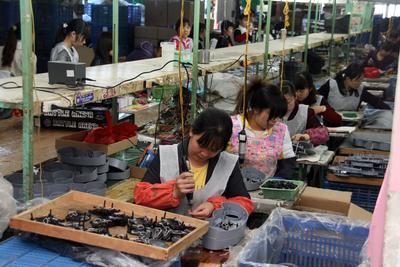China has been remarkably successful in designing industrial policies, joint venture requirements and technology transfer pressures to use FDI to create indigenous national champions in a handful of prominent sectors: high speed rail transport, information technology, auto assembly and an emerging civil aviation sector. Weighing access to the vast Chinese market against technology acquisition and management imitation on the part of Chinese partners and other indigenous competitors, prominent North American, European, Japanese and Korean manufacturing multinationals fear they may find themselves launching rivals to their own market position.
Bringing in new technology to gain access to the Chinese market — whether for domestic market penetration or as a base for exports — may, therefore, often appear to individual foreign multinationals as making a Faustian bargain with the devil. Steven Pearlstein asserts, ‘China can strike deals that may provide short-term profits to one company and its shareholders but in the long run undermine the competitiveness of the other country’s economy.’
But what is striking in the aggregate data is how relatively thin the layer of horizontal and vertical spill-overs from foreign manufacturing multinationals to indigenous Chinese firms — and consequent export externalities — prove to be.
Despite the large size of manufacturing FDI inflows, the impact of multinational corporate investment in China has been largely confined to building plants that incorporate capital, technology and managerial expertise controlled by the foreigner. Moreover, within this foreign firm-dominated production array, FDI payments for Chinese materials and labour used in the operations of foreign plants have increased as domestic value-added has increased. But Robert Koopman et al find that the expansion of domestic content (and, conversely, the decline in import content) is concentrated at the low-skill intensive sectors of processing trade exports. As the skill-intensity of exports increases, the percentage of the value of the final product that derives from imported components rises sharply.
From a novel comparative perspective, the share of domestic value-added in FDI operations in China in high skill-intensive sectors, such as computers and telecommunications, ranges from less than one-half to slightly more than one-half of what is found in other developing countries where comparable measurements can be made, such as Mexico.
Econometric analysis and survey data show that neither horizontal spillovers from — nor strong and vibrant vertical supplier relationships to — the vast FDI presence in China have taken place in any dramatic way, and difficult and complicated reforms are likely to be required before they do. These reforms include improving the doing-business climate for private Chinese domestic firms, submitting state-owned enterprises to competitive market forces, upgrading worker skills, creating engineering and managerial talent, reforming financial institutions and improving infrastructure.
Across the expanse of the Chinese domestic economy, the accumulated evidence simply does not show FDI to be a powerful source for indigenous-controlled industrial transformation. In the case of exports, the production of increasingly sophisticated goods destined for international markets from China has been remarkably well constrained to, and contained within, the plants owned and controlled by foreign multinationals and their international suppliers. China has remained a low value-added assembler of more sophisticated inputs imported from abroad — a ‘workbench’ economy largely bereft of the magnified benefits and externalities from FDI enjoyed by other developing countries.
So where do the gains from FDI in China end up?
In their dissection of the ‘value-capture flows’ for Apple’s iPod — that demonstrates no more than $4 of the final sales price of $299 (2005) remains in China — Greg Linden et al suggest that the value-added, attributed to the parent company that contributes a component or performs an integrative function to a product in China, flows directly back to MNC headquarters. But this is almost surely too simplistic — especially for US MNCs — given the American territorial tax system with the foreign tax credit and deferral that encourage US MNCs to use transfer pricing to keep accumulations of earnings offshore.
Rather than try to track down capital flows and hiding places within integrated MNC networks, the more sensible approach is to ask a slightly different question: if MNC headquarters use earnings from China, like earnings from elsewhere, to fortify their corporate position in world markets, what kinds of activities will those earnings help maintain or expand, and where will they be located?
In answering this question, it is striking to note — even in today’s globalised world — how remarkably home-based MNCs from developed countries have remained.
For the US the most recent data show that US-headquartered MNCs have 70 per cent of their operations, make 89 per cent of their purchases, spend 87 per cent of their R&D dollars and locate more than half of their workforce within the US economy. This predominant focus on the home economy has persisted over time and changes only very slowly at the margin.
The home-market-centred orientation for MNCs across the developed world is not dissimilar.
Thus while manufacturing MNCs may build plants in China — or shift production to Vietnam, outsource to Mexico, take a chance in Costa Rica or the Czech Republic, develop a new application in Israel — the largest impact from deployment of worldwide earnings is to bolster production, employment, R&D and local purchases in their home markets.
Dr Theodore H. Moran is the Marcus Wallenberg Chair in International Business and Finance at Georgetown University and a Non-Resident Senior Fellow at the Peterson Institute for International Economics. This is an abridged extract from the working paper: Theodore H. Moran, Foreign Manufacturing Multinationals and the Transformation of the Chinese Economy: New Measurements, New Perspectives (Washington, DC: Peterson Institute for International Economics) forthcoming in 2011.


This link (http://www.bea.gov/scb/pdf/2009/08per%20cent20August/0809_mnc.pdf) leads to a busted page. But, if this conclusion is correct, does that mean that the “hollowing out” of American industry has not resulted in a shift to China, but to the HQ’s of the multi-national corporations?